Uniqueness In Best Ball Tournaments
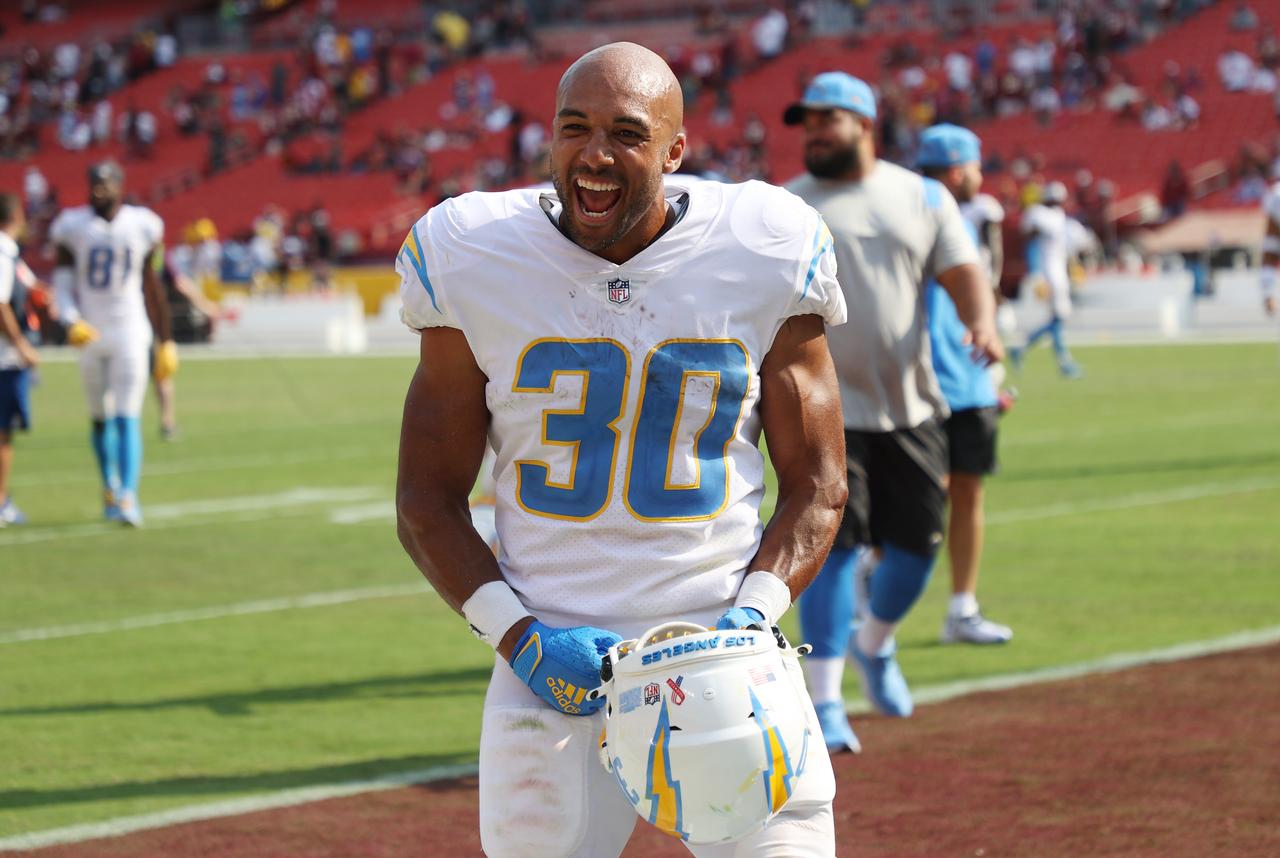
“Getting unique” was the DFS phrase of the 2021 NFL season. It’s easier to get unique in that format because players are rostered between 0-50% of the time with most players hovering at or below 10%. Simply sprinkle in one or two players with sub-5% ownership, and the roster is getting unique.
In best ball, most players are rostered 100% of the time. We don’t get sub-100% rostered players until we get into Round 15 or so. It’s simply much harder to get unique in these huge best ball tournaments, but I’ll try to map out ways to add some uniqueness, though I fear this “getting unique” concept will just create bad teams in the sake of uniqueness when it should be a tertiary thought behind Contingent Based Drafting and understanding roster construction.
Leveraging “Drafted Rate” Late In Drafts
This is the best ball concept that most reflects the DFS low-ownership concept, but it only means so much as the players who largely go undrafted are usually completely worthless.
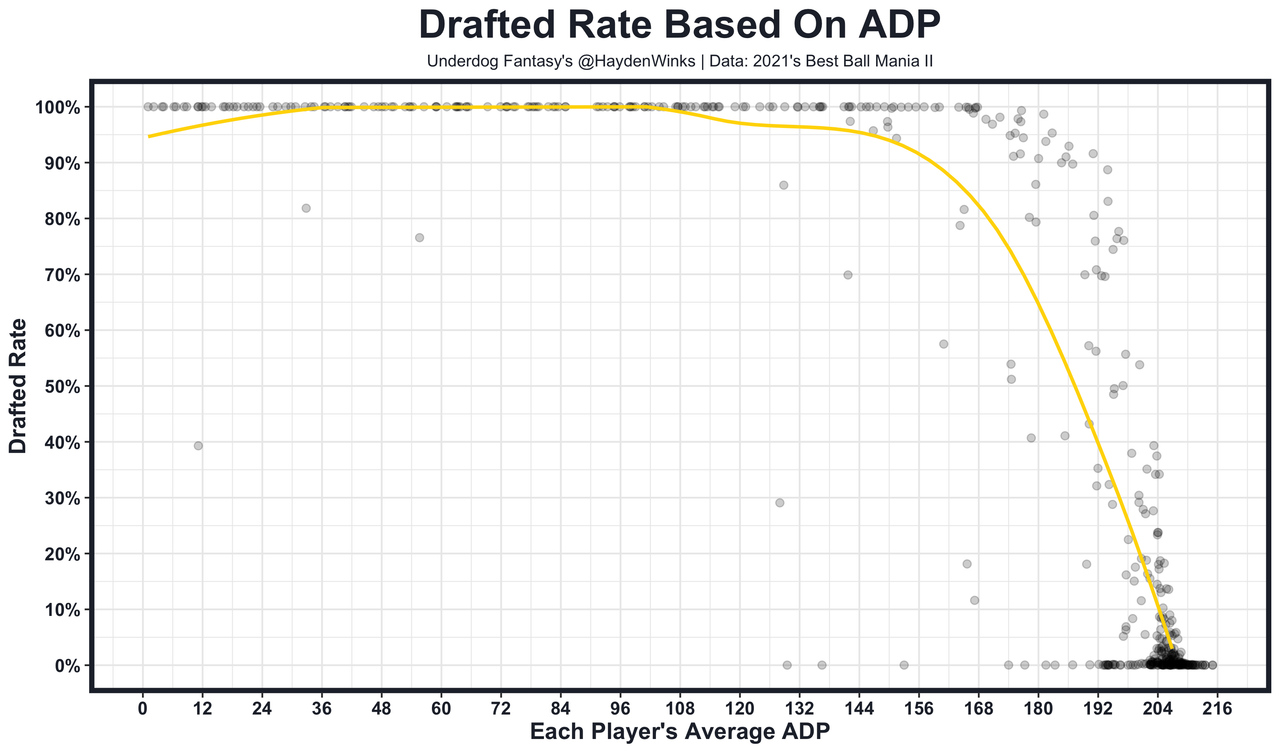
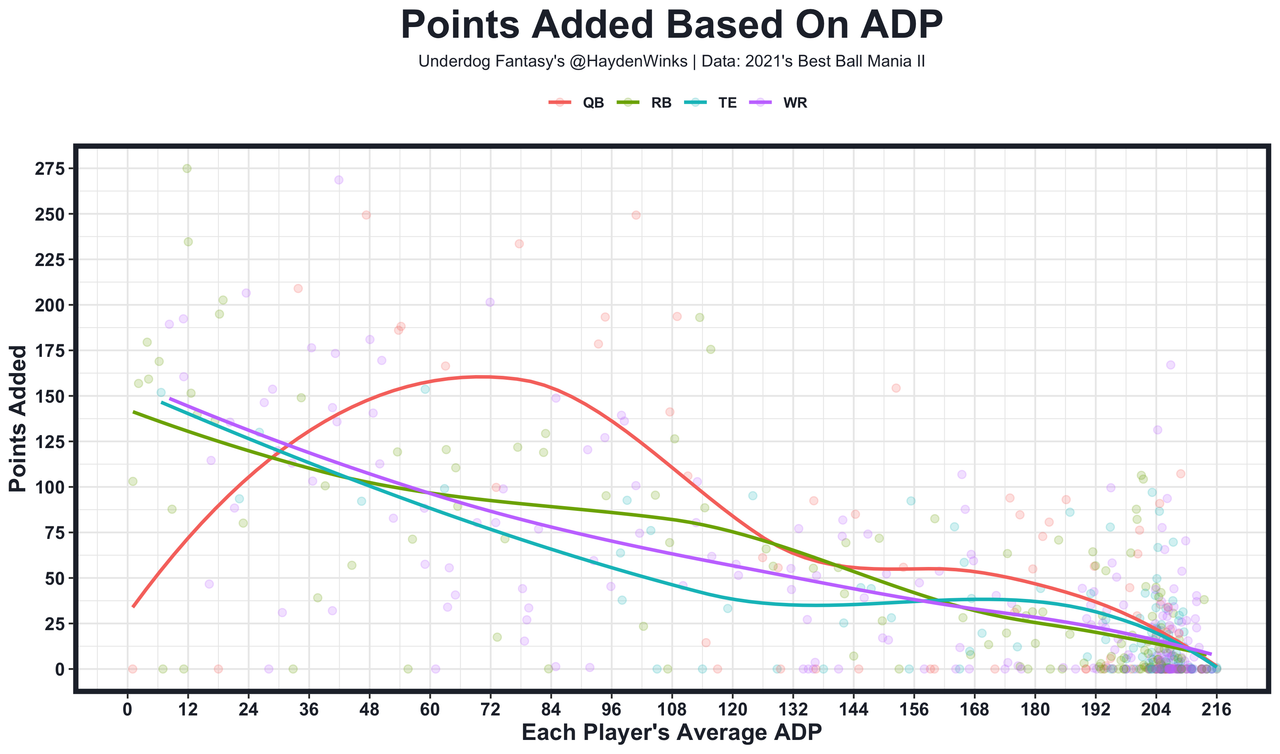
With that said, Cordarrelle Patterson (5% drafted rate at an average ADP of 207), Hunter Renfrow (34% at 204 overall), Elijah Mitchell (5% at 201 overall), Dawson Knox (39% at 203 overall), Jimmy Garoppolo (8% at 205 overall), Dalton Schultz (13% at 205 overall), K.J. Osborn (0.1% at 210 overall), and Khalil Herbert (0.7% at 204 overall) were all smashes in the final two rounds of drafts.
There appears to be a pretty big difference between a player's upside who is going near 200th overall versus at 212th overall. Just look at the second chart after pick 204th overall versus right before that. What's great about this 205th overall range is that their drafted rate is still sub-40% and oftentimes under 10%, so we're still benefiting from their relative uniqueness without picking practice-squad type players.
The strategy I like best after looking at this data is targeting a player with an ADP in the 190-205 range in Round 16. A player with an ADP of 195 projects basically as well as a player with an ADP of 175, but the drafted rate goes from 75% to 25%. And since players with an ADP of 190-205 largely go undrafted already, I’m fine with stockpiling this range in Rounds 16, 17, and 18 rather than looking in the 0-1% drafted rate bucket of players who typically don't even get offensive snaps.
I’ll write a “sleepers” column and we'll do a sleepers show on YouTube later this summer to highlight some names for the 2022 season.
Pairing QBs/TEs With The Same Bye Week
It’s obvious that drafting two QBs with the same bye week will result in fewer regular season points (somewhere between 10-18 points) and that will result in a lower advance rate because 16.7% of best ball leagues are decided by 10 or fewer points. But if nobody is pairing these same bye week QBs, then there could be a uniqueness advantage in the best ball playoffs. Here’s how often it’s happening, so you can decide for yourself:
Last year, Dak Prescott was paired with the following similar-ADP QBs:
Trevor Lawrence (same bye) 3.6% vs. Justin Fields (different bye) 6.1%
Kirk Cousins (same bye) 3.2% vs. Baker Mayfield (different bye) 6.4%
Ben Roethlisberger (same bye) 3.6% vs. Daniel Jones (different bye) 6.4%
In general, two QBs with the same bye are going to be paired around 3-4% of the time compared to about 6-7% for two QBs who have different bye weeks in the same ADP range. That matters, I guess, but it’s not the craziest uniqueness difference, so my final bye week take is: it doesn’t really matter either way.
Pairing QBs/TEs With Very Similar ADPs
Instead, my favorite way to get unique at QB isn’t the bye week strategy, it’s pairing two QBs together with very similar ADPs. Drafters typically don’t like double-tapping QBs because it gets them off-balance, and it’s harder to get two QBs with similar ADPs because other drafters are simply drafting them before we’re back on the clock. But this creates a uniqueness gap that doesn’t come with the lost points of pairing bye week QBs.

Last year, QBs with very similar ADPs in the Round 6-12 range were paired together 3-4% of the time compared to 6-7% of the time when their ADPs were separated. For example, Russell Wilson (ADP: 73rd) was paired with Justin Herbert (77th) just 3.3% of the time compared to 6.1% and 5.7% with Tua Tagovailoa and Justin Fields, who were both going much later in the draft. The same was true with Jalen Hurts/Tom Brady/Justin Fields and Joe Burrow/Matthew Stafford/Tua Tagovailoa. And to no surprise, Dak Prescott and Russell Wilson were paired together only 2.2% of the time as they both 1) shared the same bye and 2) had similar ADPs.
This is really dope because I was already arguing that drafting two QBs semi-early was +EV.
Getting Weird In Round 2
It’s 2021 Best Ball Mania II Austin Ekeler case study time. Ekeler smashed with an ADP of 12.1 overall (and he had a tight standard deviation of 2.7, so he was almost exclusively drafted at the Round 1/2 turn). He's the perfect case study because he was good and we can see how mixing up the draft in Round 2 can make us unique. Here's how often he was paired with various players going somewhat near his ADP:
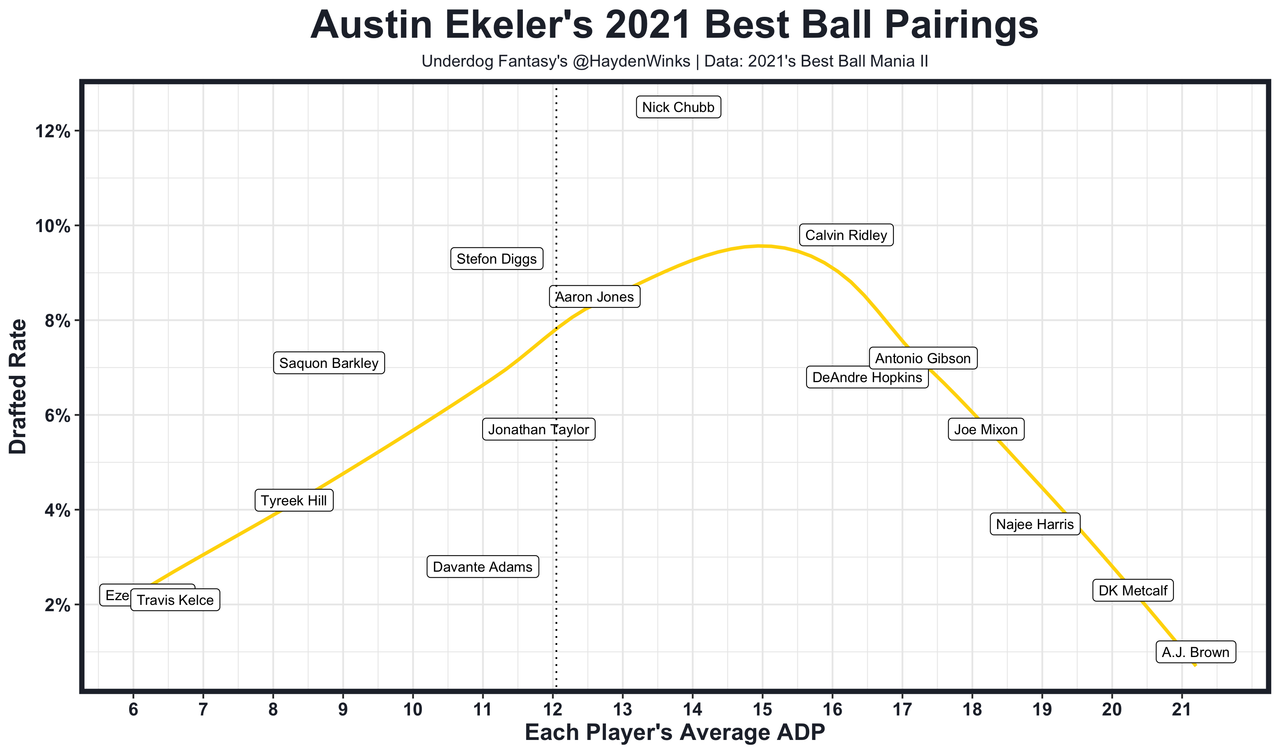
To no surprise, Ekeler was most commonly paired with the players whose ADP were also near the Round ½ turn (Nick Chubb, Calvin Ridley, Aaron Jones, and Stefon Diggs). The question is if it’s smarter to keep drafting these common pairings, or if it’s better to get slightly more unique by drafting different players at the Round ½ turn?
The most +EV move for these Ekeler teams is to draft the consensus Round 1 player who just happened to fall, as these players both projected best and were uniquely paired with Ekeler. For example, Tyreek Hill was only paired with Ekeler 4% of the time because Hill (ADP: 8.1) rarely fell far enough to where he’d be commonly paired with Ekeler’s 12.1 ADP. So it’s probably best to draft consensus top-12 players in ADP together whenever possible ... No shit.
The actual debate is whether to pair Nick Chubb (ADP: 13.8), Calvin Ridley (16.2), or Najee Harris (18.9) with Ekeler. The projections between Chubb, Ridley, and Harris going into last season were all basically the same, but Ekeler was paired with Chubb 12.5% of the time compared to 3.8% of the time with Harris. If you’re looking for unique pairings that don’t sacrifice too many points, then draft a Round ½ turn player with a player who is commonly drafted 17th to 24th overall.
If you want to get even crazier, draft two players who are being drafted in the middle of Round 2 together at the Round ½ turn. Last year’s RB examples were Antonio Gibson (ADP: 17.3), Joe Mixon (18.2), and Najee Harris (18.9). Here’s how often they were paired together:
Joe Mixon + Najee Harris (1.5% paired)
Joe Mixon + Antonio Gibson (0.9% paired)
Najee Harris + Antonio Gibson (1.5% paired)
Making “Zero RB” More Unique
Compared to the Austin Ekeler teams, Stefon Diggs drafters selected more WRs than RBs at the Round ½ turn.
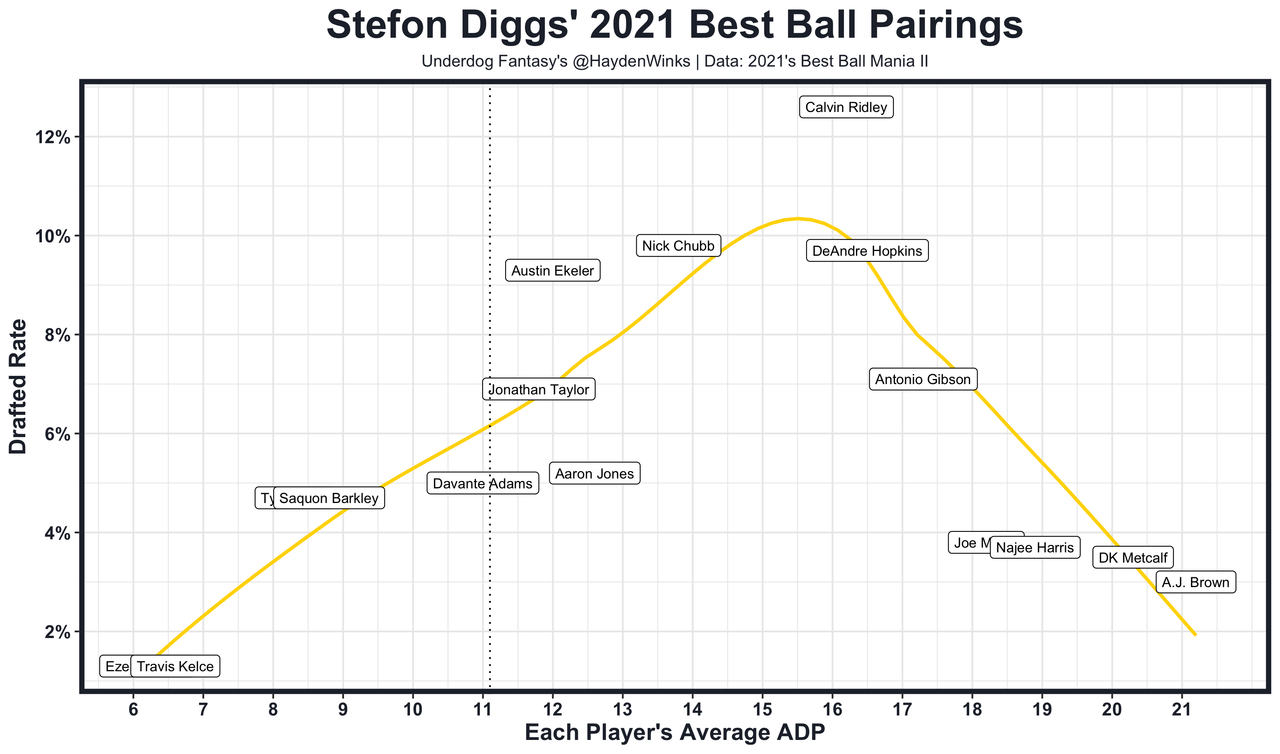
Davante Adams (3% paired with Ekeler versus 5% paired with Diggs = +2% difference), Calvin Ridley (+2%), DeAndre Hopkins (+2%), DK Metcalf (+2%), and A.J. Brown (+2%) versus Saquon Barkley (-2%), Aaron Jones (-3%), Nick Chubb (-2%), and Joe Mixon (-2%). This, of course, is because the Zero RBers have no chill.
Despite being a lower-used strategy in general, the Round ½ pairings Zero RBers fall into are often common-enough to cross out some of the uniqueness of the strategy as a whole. So how do we make these Round ½ WR/WR pairings more unique? Like outlined in the previous section, the easiest way last year was to pair Stefon Diggs (ADP: 11.1) with DK Metcalf (20.2) instead of Calvin Ridley (16.4). That lowered Diggs' pairing rate from 12.5% to 3.8%.
The next easiest (and maybe the better) way to get “unique” with these WR/WR starts is to do either one of these two weird things: 1) go RB/RB at the Round ¾ turn, or 2) execute an “Even More Radicalized Zero RB” build.
WR/WR start teams who were drafting from the 7-12 spot selected zero RBs 5,778 times, one RB 4,813 times, and two RBs 1,323 times at the Round ¾ turn. Most of these WR/WR start teams are going to lean into traditional Zero RB builds, so quickly pivoting off of that by going RB/RB in Rounds 3 and 4 makes it a very unique start.
And here’s a snippet from Even More Radicalized Zero RB: “Teams that finished with 6 or 7 WRs after hammering the position early averaged just above a 20% advance rate, compared to a 15.7% win rate for teams that drafted 9 or 10 WRs after hammering the position early. Not only is drafting fewer WRs more productive, but it’s also more contrarian. There were only 3,622 teams that went the 6-7 WR route versus 8,415 teams that had 9-10 WRs. And the 8 WR teams (n = 8,054) were still performing worse than the 6-7 WR teams and were the most popular.”
Caveat
All of the data and examples used in this column were based on last year's entire summer of drafting. Because players' ADPs move throughout the summer, it's best to use these uniqueness strategies when these best ball tournaments are either closed to fill (read: August/September for Best Ball Mania) or for tournaments that are designed to fill quickly (read: The Puppy). This way you know that these pairings are actually unique.
Conclusion
“Getting unique” is more important and easier to do in DFS compared to best ball because how often players are rostered in each format. There are still plenty of edges to dig into with Contingent Based Drafting, roster construction, Week 17 stacking, and player archetypes, so building really unique teams should be more of an afterthought at this point in my opinion. With that said, there are simple changes that add some uniqueness that don’t punt off a large chunk of advance rate: attacking the 180-205 ADP range hard, double-tapping QB in the middle rounds, getting weird in Round 2, and pivoting off traditional Zero RB builds. Any one of these strategies could make one of your Best Ball Mania III finals teams just different enough to cash in the $2 million grand prize.